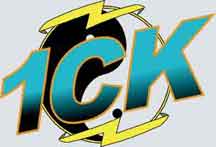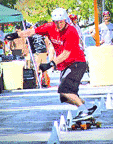Wesley Tucker wrote:The answer is ELIMINATING the "pro" class.
We have no "pros." We have a few skaters racing for beer money and some free equipment from their sponsors. Every once in a while a skater gets someone to pay for a plane ticket.
Sorry, that ain't pro, I don't care how you argue otherwise.
We need "A", "B" and "C" class brackets established for every race through qualifying. No one shows up and declares they are a "pro" and since there's only 13 they get in the bracket while the 40 "Open" skaters are scratching and clawing to not be one of the 24 left spectating. THAT'S a problem.
I think you are wrong Wesley... and I will throw out some argument for discussion... I'm disappointed that an ISSA leader makes blanket statements about not caring how others might argue his point. To quote you back, "THAT'S a problem"
The sport has been going backwards for several years and eliminating the PRO bracket is another mistake. You aren't a PRO and you seldom attend races so I think my opinion counts for something. Your opinion means less to me each year. You are racing hard from the keyboard and this forum, but not from the street where it also matters. Think a little for once before you spout off.
At a smaller race (say less than 8 Pros attending) the A/B/C All Open makes sense. In 2004 Fluitt and I were the ones that really pushed the whole idea of Open qualifying in the American Cup Series. Many Pros were "caught" in that division and didn't want to be there, but also couldn't really drop back to Open. Hot Open riders were hesitant to move up. The Open qualifying made them all race together. The downside was the creative sandbagging that still exists today (i.e. How purposely slow can I go to make the B bracket near the top, but not the A bracket near the bottom)
When the FCR series ran in 2002-2003 there were generally 16 qualifying spots open for Pro and 16-32 qualifying spots open for Am. If you didn't make the cut, then you didn't race.
SteveP asked how they run things in Europe. In most of the races I have attended their (Paris, Stockholm, Hannover), this is exactly how they still do it. If you are not a top-16 Am then you take your 2 Q-runs and then watch the top 16 Pro and Am battle it out.
With the field quickly narrowed down after qualifying there is time to have two different courses set if necessary. Remember that running a 32-bracket down to 16-bracket takes the same amount of time as running an entire 16-bracket completely, including the consolation rounds.
Sound unfair? Perhaps. When I first started in 2002, the goal was to make the cut. It took a while and newbies either quit or practiced and got faster. I chose to practice and get faster. I didn't expect an easier course and a larger bracket so I could say I got to race.
Racing in the US has been dummied down over the last few years. Each year, our equipment gets better and yet the courses get sloppier. It still seems the normal goal of a promoter is to make sure everyone, even the newbie, can make every course. The point is understandable since most of an organizer's revenue still comes from entry fees.
Wesley Tucker wrote:
Until we grow to the point there's guaranteed cash purses in excess of $5,000 paid out to the top six (at least), then "pro" is just ego stroking
Here is why I argue for maintaining the Pro class and making courses significantly more difficult. I have talked to many business owners in a position to throw some money our sport's way. The consensus is that they want gnar, more potential for wreckage, something more extreme. Watching an unskilled "racer" plow cones or DQ is not something they generally want their name attached to, nor is it something that lends itself towards TV or major media.
Donald's idea of running an "invitational" race in Austria where only the top Pro/Am racers were invited was met with lots of hostility. Individuals threatened to start their own race organizations. The invitational idea may be a little new, but the idea of only the top racers performing in the Head To Head Elims is not.
Two seasons ago the ISSA made a bunch of noise about standards for different disciplines, but yet the max cone distance is generally ignored in almost every TS race in the last two seasons. Why? Generally to minimize double-DQs, minimize cone carnage, and "prove" to the spectators how skilled the racers are. What the heck was the max cone distance rule even put down into a rulebook for? Go measure the cone spacing a Hood TS the last 2 years (both Majors). You will find that it did not meet the ISSA rules.
The HS is almost the same. You now use GS board for HS and HS board for TS. Maybe even a DH/SGS board for GS.
Please think a little longer next time before you call for the complete elimination or something like the Pro division...
P.S. The next race I organize will not be an ISSA sanctioned event, but it will have a good prize purse, plenty of technical challenges, more speed, and invitations to the top racers in the world...















